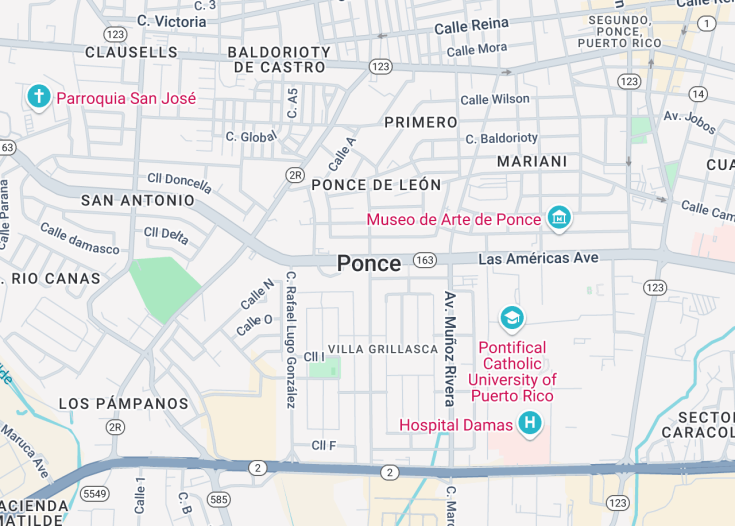Ponce, the second largest city in Puerto Rico, fondly known as “La Perla del Sur” (The Pearl of the South), boasts a rich tapestry of cultural heritage and architectural splendor. Visitors can explore an array of museums, historical buildings, and vibrant street art, which reveal the city’s eclectic past and artistic flair.
The downtown area, with its meticulously preserved colonial architecture, offers a picturesque backdrop, while nearby natural attractions like Caja de Muertos Island provide a serene escape from urban life.
Before visiting Ponce, consider planning your trip during the local festivals like Carnaval Ponceño for a vibrant experience of music, dance, and traditional celebrations.
Make time to visit the Parque de Bombas, an iconic red-and-black striped former fire station turned museum, which stands as a testament to Ponce’s historical resilience and community spirit.
Top things to do & see in Ponce
Select the following sights and activities to discover best tickets and tours available in Ponce.
Ponce: The Vibrant Heart of Southern Puerto Rico
| Country | Puerto Rico |
| Time in Ponce | GMT-4 |
| Language spoken | Spanish |
| Population | 133,191 (U.S. Census Bureau, 2020) |
| Currency | United States Dollar (USD $) |
| Airports |
|
Ponce, located on the southern coast of Puerto Rico, is the island’s second largest city and one of its most culturally rich locales. Known as “La Perla del Sur” or “The Pearl of the South,” Ponce boasts a storied history and a vibrant cultural life that attests to its past and present significance. Founded in 1692, the city’s architecture, museums, and public spaces are a testament to its historical richness.
The Ponce Historic Zone is a treasure trove of late 19th-century colonial architecture, meticulously preserved and reflecting the opulence of that era. Historically, Ponce has been an economic powerhouse, initially through its agricultural industry, particularly sugarcane production, and later through its development as a major shipping port. The city has always served as a cultural beacon in Puerto Rico.
Its contributions to music, art, and literature feature prominently on the national stage, with institutions like the Ponce Museum of Art holding the largest art collection in the Caribbean. Culturally, the city celebrates a mix of African, Spanish, and local Taíno influences, which are visible in its music, culinary scene, and day-to-day life. The annual Carnival of Ponce, held before the Lent season, is a vibrant and colorful celebration that draws visitors from across the world, featuring traditional music, dances, and a parade of masks made from coconut shells.
Ponce is not only about its past; today, it is a growing hub of economic activity and educational growth, home to several of Puerto Rico’s top higher education institutions. Natural beauty surrounds it, too, with nearby beaches and the mountainous backdrop providing a scenic contrast to the urban layout. For both visitors and locals, Ponce offers a compelling blend of traditional elements and modern conveniences, making it a must-visit destination for anyone interested in the complete Puerto Rican experience.
Where is Ponce?
Located on Puerto Rico’s southern coast, Ponce is nestled between the central mountain range and the Caribbean Sea.
Distances:
| Route | Distance by car | Time by car |
|---|---|---|
| San Juan to Ponce | 73 miles | 1 hour 30 minutes |
| Mayagüez to Ponce | 40 miles | 1 hour |
What is Ponce famous for?
Ponce is renowned for its rich cultural heritage, particularly its historic architecture and vibrant festivals such as the Ponce Carnival, one of the most significant and elaborate celebrations in the Caribbean.
History
Before the 16th Century: The Indigenous Era
Before the arrival of the Spanish, the area known today as Ponce was inhabited by indigenous Taíno people. These well-organized societies engaged in agriculture, fishing, and hunting, and had developed a rich culture of music, art, and spiritual practices.
1508-1692: Spanish Colonization and Foundation
Ponce’s modern history began with the Spanish colonization of Puerto Rico. The region was officially founded in 1692 by Juan Ponce de León’s great-grandson, Lozano Ponce de León, ensuring Ponce’s importance from its inception. This period was marked by the rapid development of the agricultural economy, primarily focusing on sugarcane, coffee, and tobacco.
1692-1898: Growth and Development
During this time, Ponce became one of the most developed and wealthy areas in Puerto Rico due to its booming plantation economy. It also saw the construction of significant architectural landmarks and the establishment of a powerful political and economic elite.
1898-1952: American Influence and Modernization
With the advent of American rule following the Spanish-American War in 1898, Ponce underwent significant transformations as new technologies and political ideals entered the region. Infrastructure such as roads and electricity was established, paving the way for modern urban development.
1952-Present: Contemporary Challenges and Development
Since becoming part of the Commonwealth of Puerto Rico, Ponce has faced both challenges and successes. Despite grappling with industrial changes and economic fluctuations, it remains a cultural and economic hub, celebrating its rich heritage while continuously evolving.
Visit Ponce
What to see and do in Ponce
Exploring Ponce, Puerto Rico, offers a blend of cultural, historical, and natural attractions. Key sites include:
- The Ponce Historic Zone, where visitors can admire colonial architecture and museums like the Ponce Museum of Art.
- Castillo Serrallés, a grand former sugarcane plantation mansion, now a museum that tells of the island’s sugarcane legacy.
- La Guancha Boardwalk, ideal for a leisurely stroll or sampling local street food.
- The Cruceta del Vigía, a large cross offering panoramic views of the city.
These sites provide a comprehensive understanding of Ponce’s rich cultural tapestry.
Festivals and Events in Ponce
Ponce is lively with festivals throughout the year, making any visit a potentially festive experience. Notable events include:
- The Ponce Carnival, one of Puerto Rico’s most important and vibrant celebrations, held just before Lent.
- The Fiestas Patronales, celebrated in December, honoring the city’s patron saint with music, dance, and food.
These events are a fantastic way to experience local culture firsthand.
Best time to visit Ponce
The optimal times to visit Ponce are between November and April. These months offer pleasant weather, ideal for exploring the city’s outdoor venues and attending the vibrant Ponce Carnival.
Is Ponce worth visiting?
Ponce is unquestionably worth visiting for anyone interested in history, culture, or simply enjoying Puerto Rico’s beautiful landscapes and architecture. It offers a unique blend of historical treasures, vibrant cultural experiences, and warm, welcoming locals.
Ponce, with its rich history and contemporary charm, provides a fulfilling escape from the typical tourist traps.










